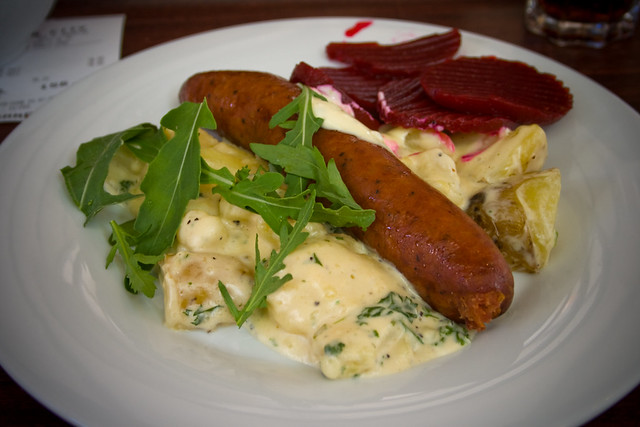


Why, then, has Swedish cuisine been an internal matter for so long and why do traditions and dishes still survive? Well, the easiest way to answer these questions is to take a look at the map. Sweden is located in the extreme north and has never been a crossroads for other cultures. A country so distant from vineyards and olive orchards had no attraction for Greeks, Romans, Arabs or Turks.
The Vikings indubitably made a feast of it in southern Europe - perhaps their memories retained a recipe or two, who knows? They traded the dried fish they carried for, among other things, salt, which was in short supply in the North. Other condiments surely found their way into the hold and, of course, tuns of wine.
When many of the armadas of Europe steered their courses toward the New World and brought home plants, fruits and spices, the Swedes were fully occupied with warring against Danes and Germans. At its apogee, the great power that was Sweden had possessions throughout the Baltic region and northern Poland and Germany. Finland was Swedish as well. In purely gastronomic terms, these contacts abroad left barely a trace except in southern Sweden, which long belonged to Denmark. A single war memento forms a part of plain Swedish fare. In the early 18th century, Karl XII and that part of the army that had survived the Battle of Poltava spent several years in Turkey and developed a fondness for Turkish stuffed grape leaves. This evolved into the belovedkåldomar the stuffed cabbage rolls, one of the showpieces of Swedish husmankost.
Naturally, the royal court, the aristocracy and the upper class had completely different gastronomic contacts. German cuisine was long prevalent, and it was German chefs who handled the cooking. French cuisine made inroads in the 18th century and when Marshall Bernadotte was proclaimed King of Sweden in 1818, French influence grew, also in restaurants.
Sweden is 1,572 kilometres long and two thirds of it are sparsely populated, in particular the northern mountain regions. To the west there is the salty North Sea, to the east the briny waters of The Baltic Sea and the Gulf of Bothnia. In addition, there are more than 100,000 fish-rich lakes and rivers.
Fish and shellfish have always formed a significant part of the diet. In Swedish fresh waters alone there are about 50 species, and fish recipes are literally innumerable.
THE RIGHT OF COMMON
Since great portions of the country are so sparsely populated, for a long time people had to make do with the raw materials available. Every region from north to south had its own specialties, depending on climate, natural resources and traditions. One thing that was common to the entire country was an abundance of wild game. The Right of Common concedes free access to all citizens to berries and mushrooms growing in the forests. Lingonberries, blueberries and cloudberries are much used in desserts and beverages. Among the most popular mushrooms are the cep, the chanterelle and the morel.
The breeding of reindeer is unique to the Nordic countries, and the Sami people, northern nomads, have made their livelihood from it for a couple of millennia. Among wild game, the most common meat is moose, and during hunting season in September/October some 150,000 moose are shot. Since a full-grown moose weighs about 700 kilograms, the supply of moose meat is plentiful. Moose doesn't really have a typically "gamey" flavour and can be prepared in the same way as beef. Deer, pheasant and rabbit usually end up in the freezers of the hunters themselves, but they are of course available in well-stocked shops.
POTATOES, BREAD AND CHEESEE Potatoes are our principal staple, although rice and pasta have gained in popularity in recent years. The potato is a plant that withstands many climates, can be cultivated in poor earth, is easy to store and is very versatile. It is an ingredient in typical Swedish dishes such as Janssons frestelse (Jansson's Temptation, a potato-and-anchovy casserole), kroppkaka (potato dumplings filled with chopped pork), pitepalt (dumplings made from raw potatoes),pytt-i-panna (potato-and-meat hash), raggmunk (thin potato pancakes) and many other beloved plain dishes. We consider the fresh potato, which is usually harvested for Midsummer, a delicacy.
Our bread traditions also vary from north to south. Only barley is able to withstand the climate of the north. In the central parts of the country, mostly rye and oats were cultivated, while wheat required fertile fields, such as those found in the southern province of Skåne.
Knäckebröd, crispbread, is exported to many countries. This is a hard, crispy and very durable type of bread, usually baked from rye or wheat flour; it is always present in the breadbaskets of restaurants and you will find it in the pantry of almost any Swede. Need we say it is wholesome, too?
Next to the French, the Swedes are the biggest consumers of cheese in the world. And when it comes to hard cheeses, there is no country that can offer as great a variety. We distinguish between dessert cheeses, the soft, creamy cheeses eaten after dinner, and hard cheeses, which can be served with the starter or the main course, always with bread and butter. A breakfast table without at least one hard cheese is unthinkable.
©carovin ab. Christine Samuelson.
No comments:
Post a Comment